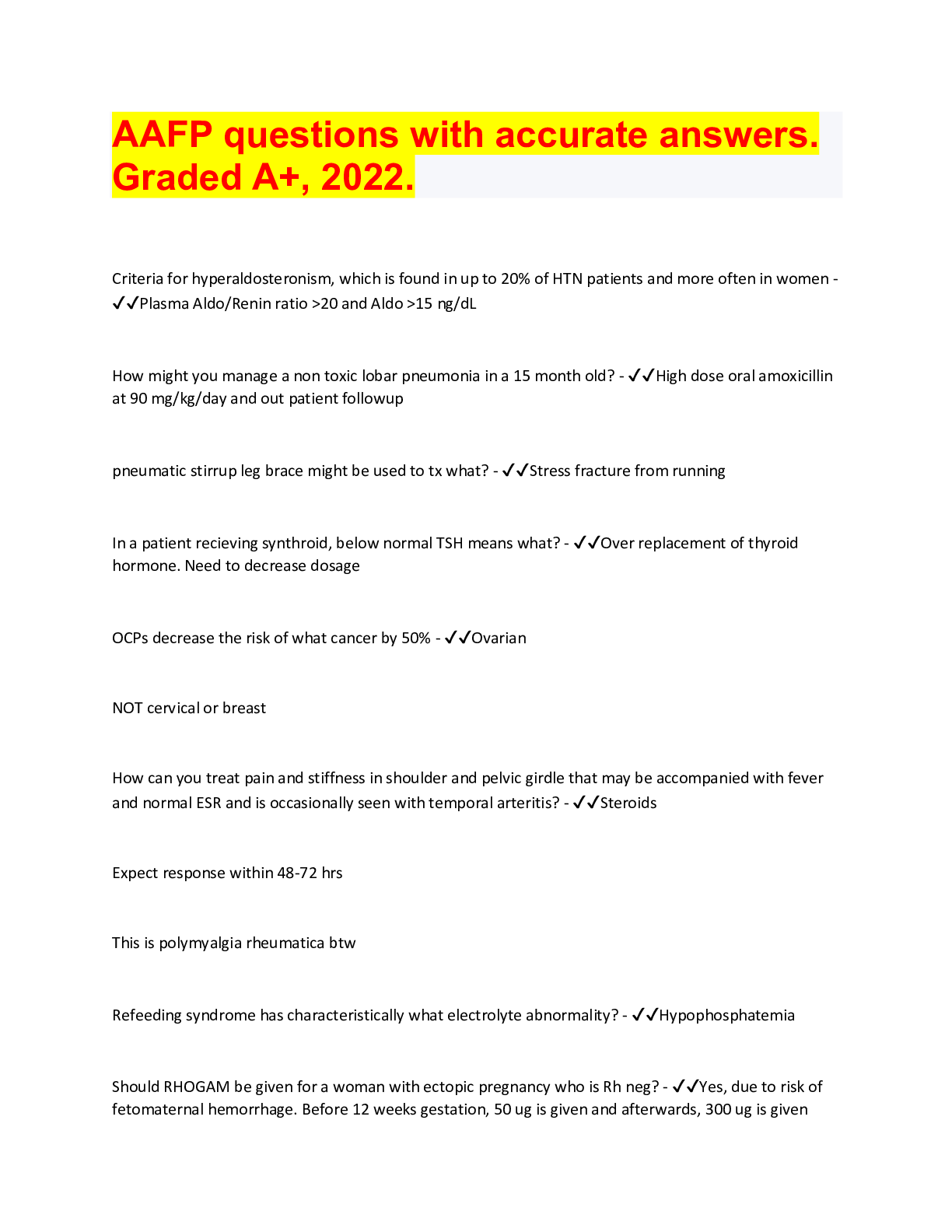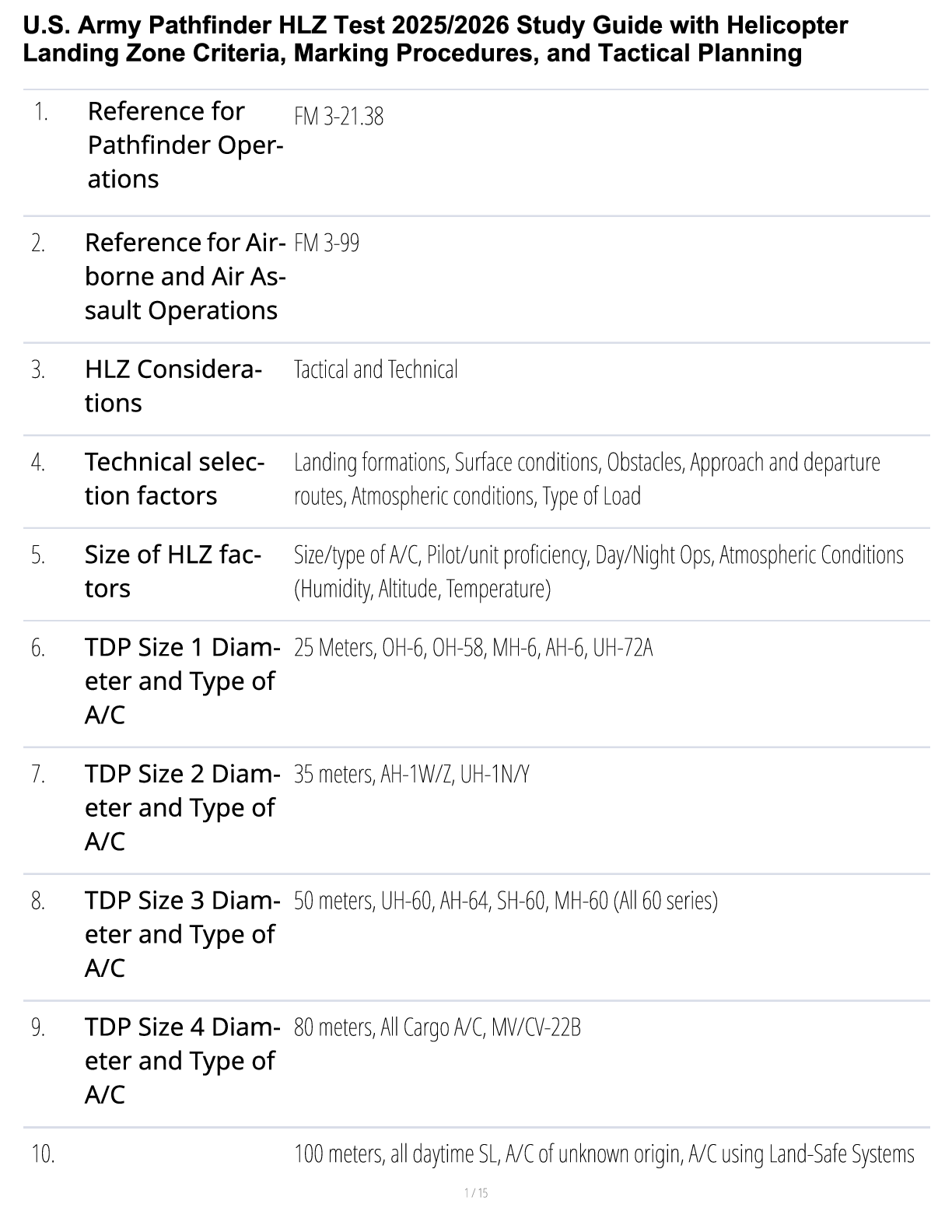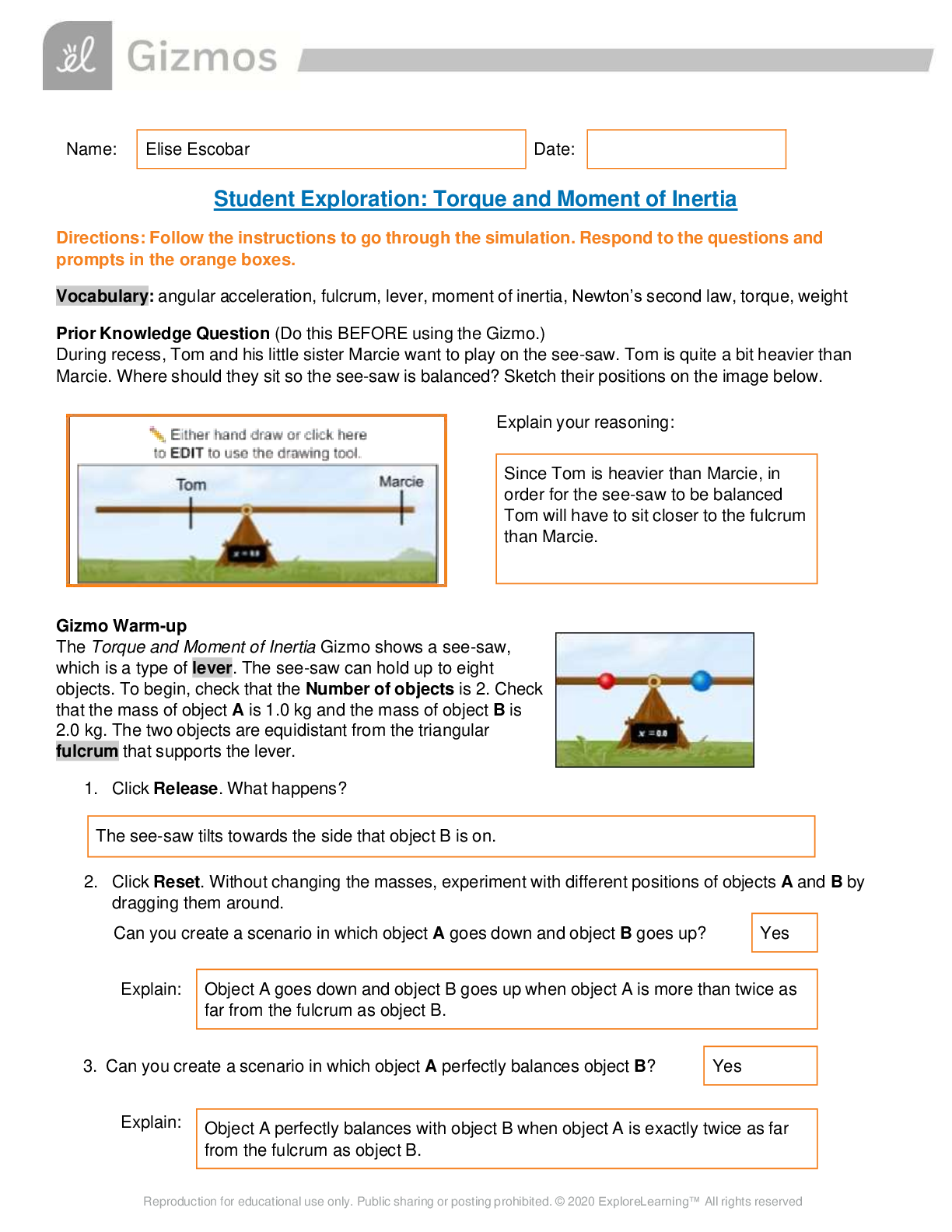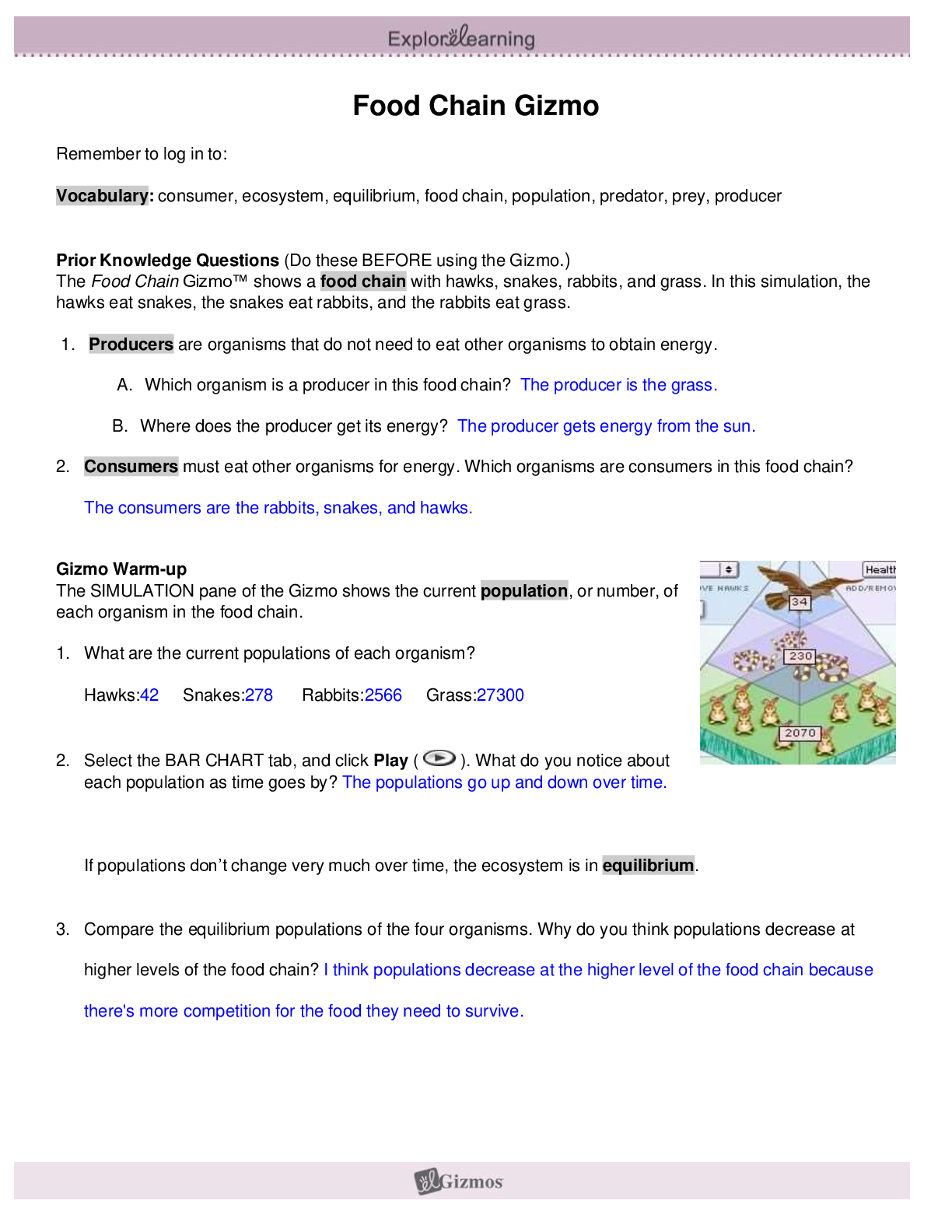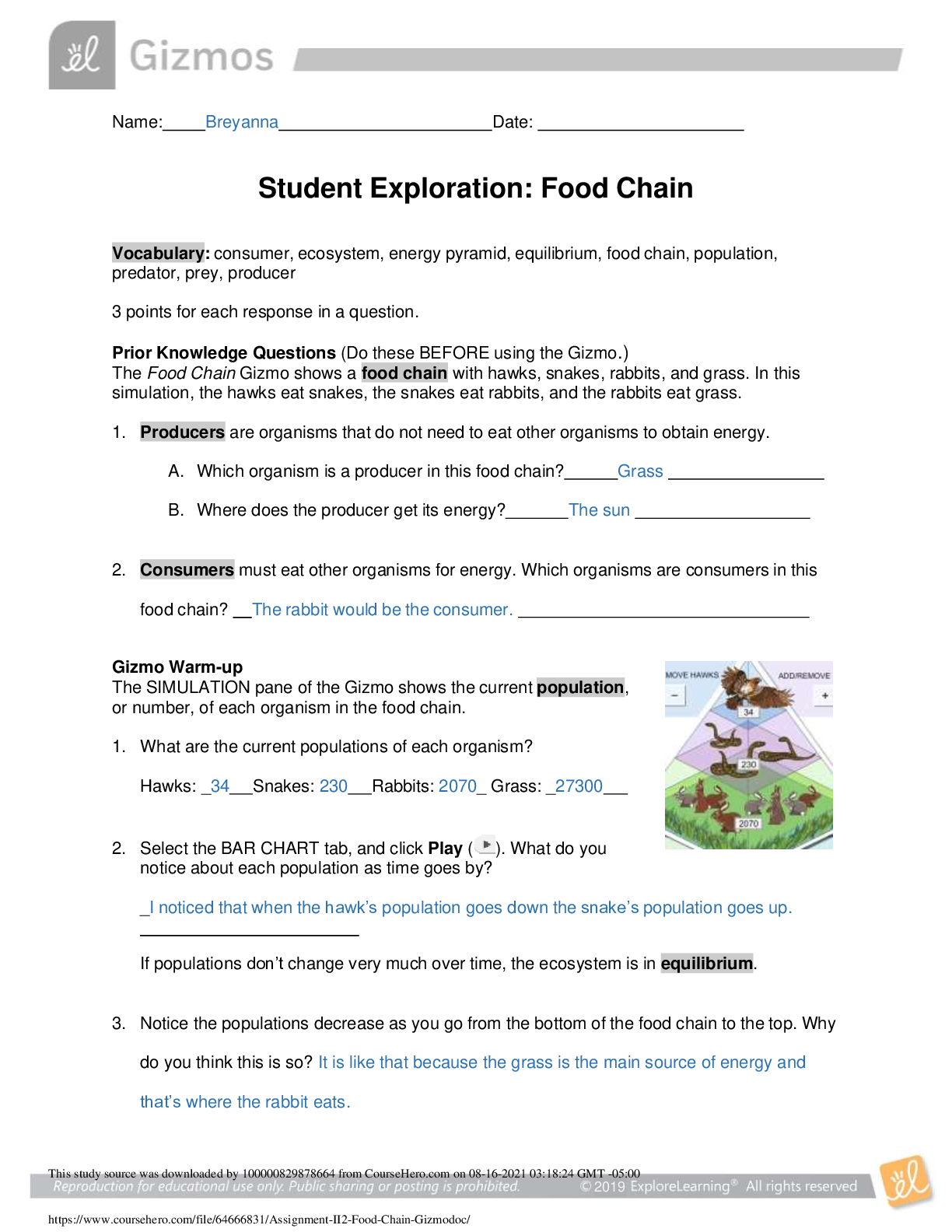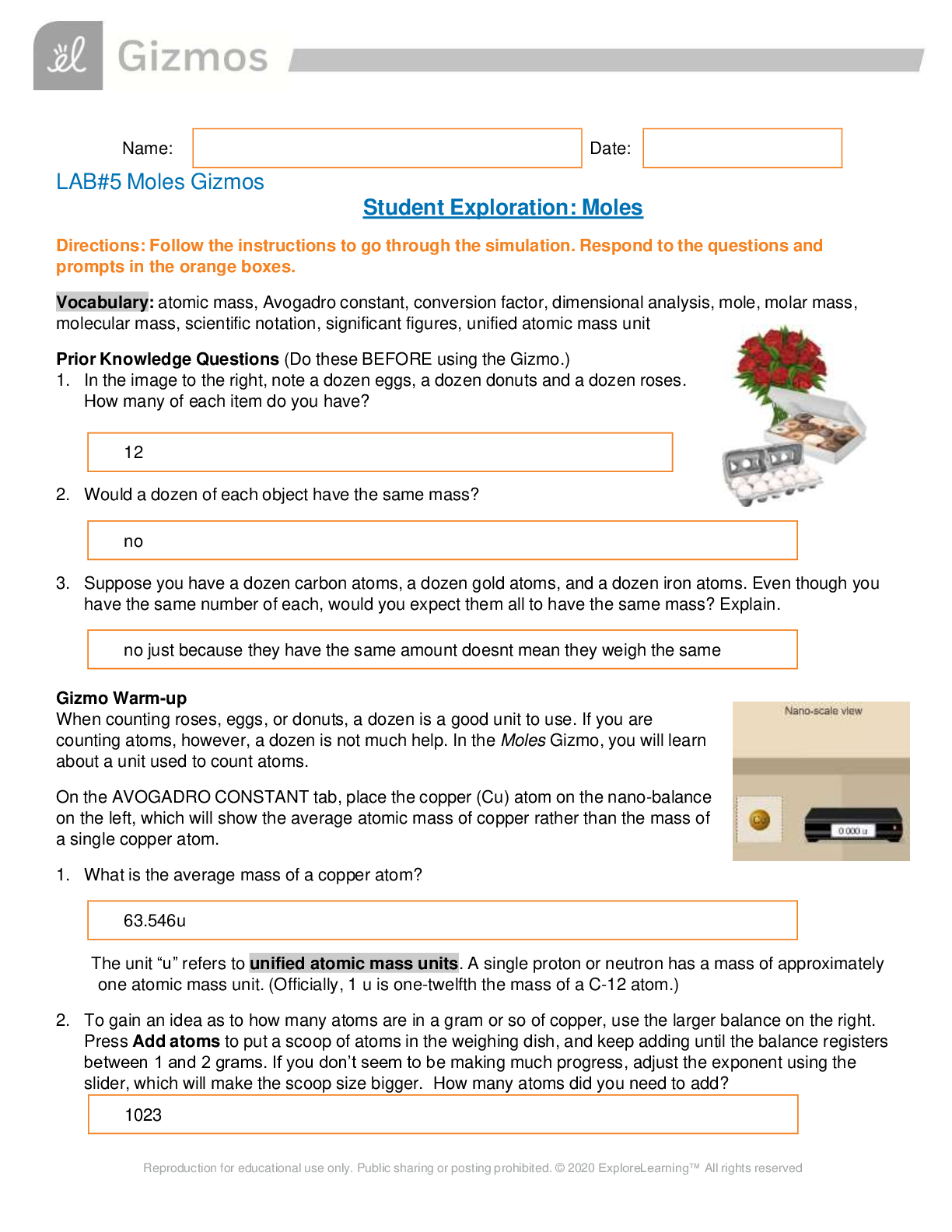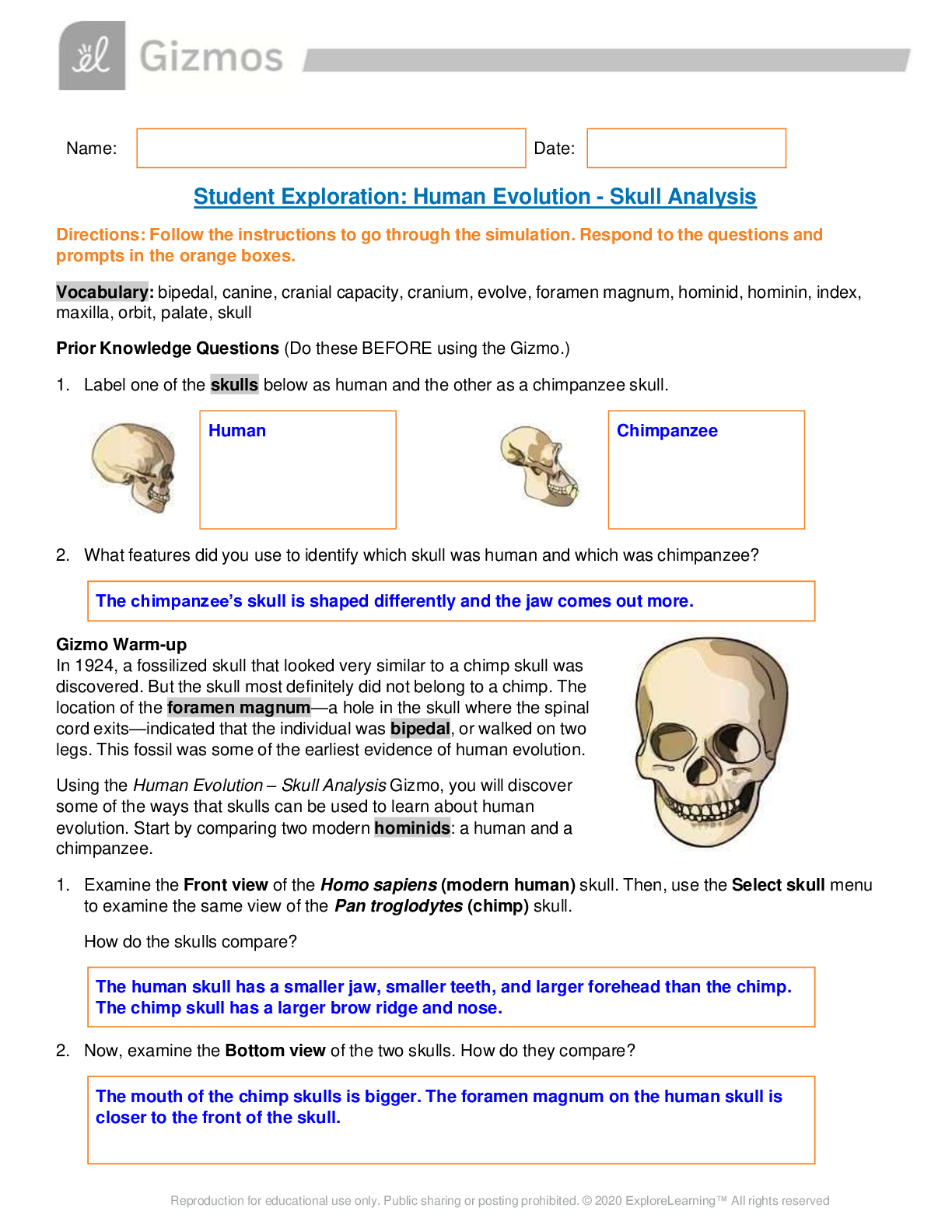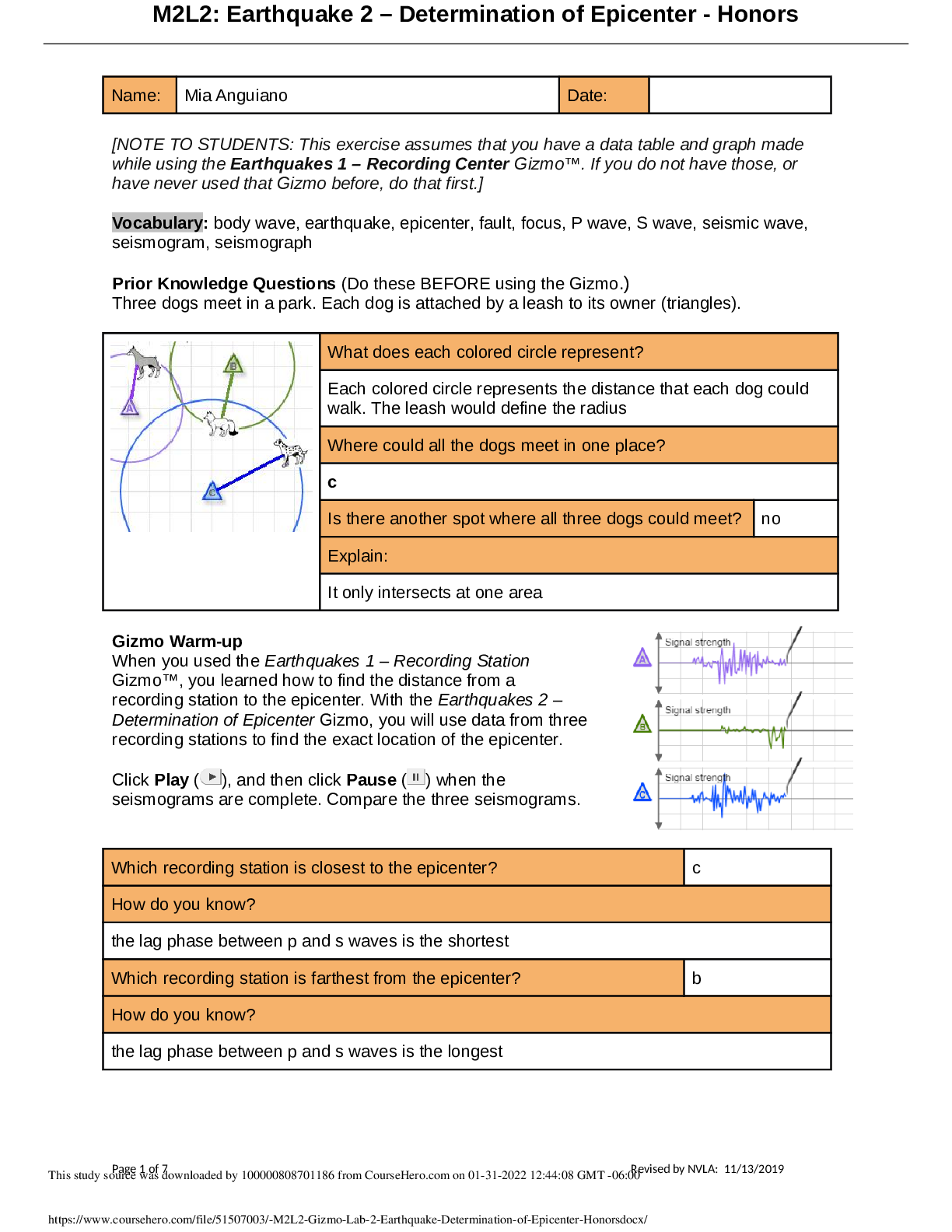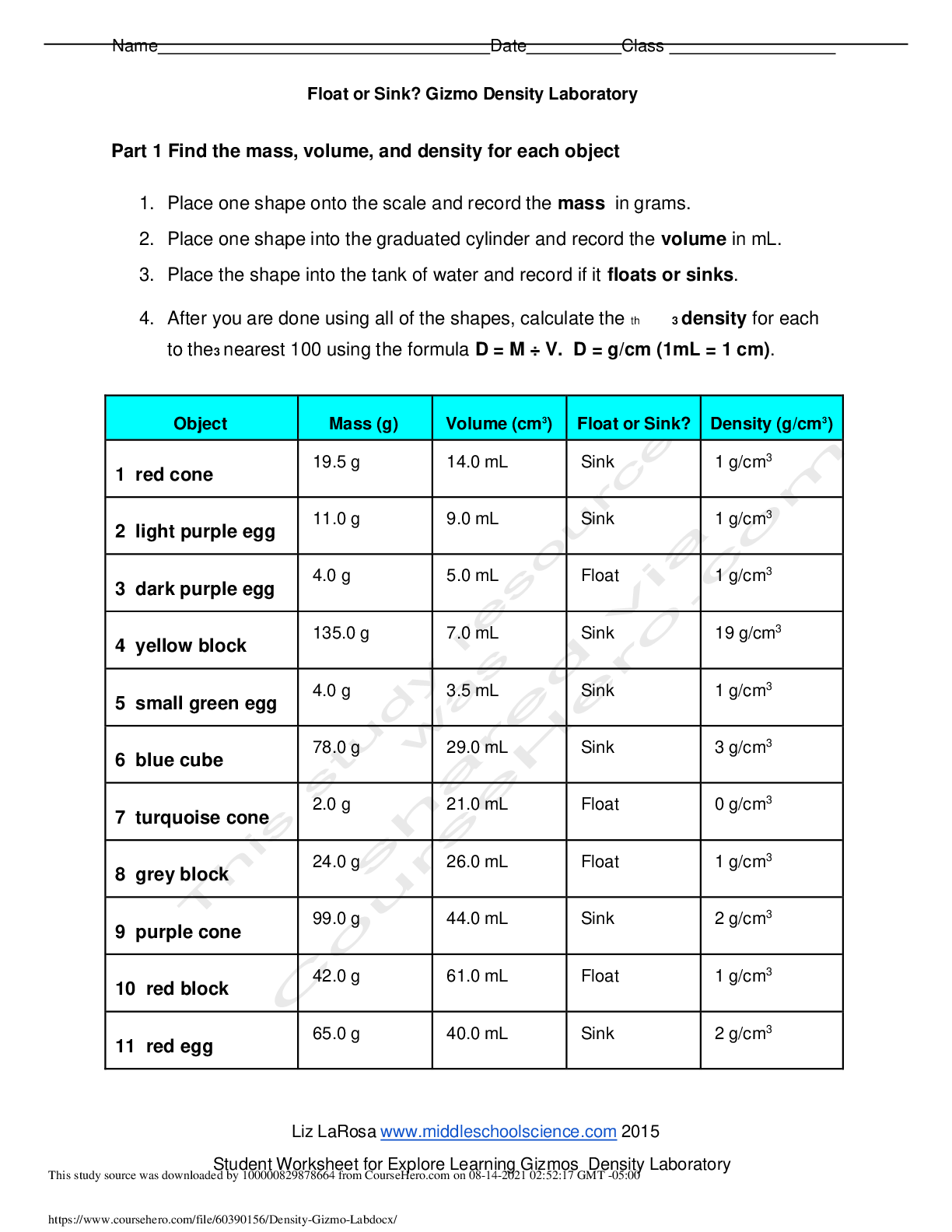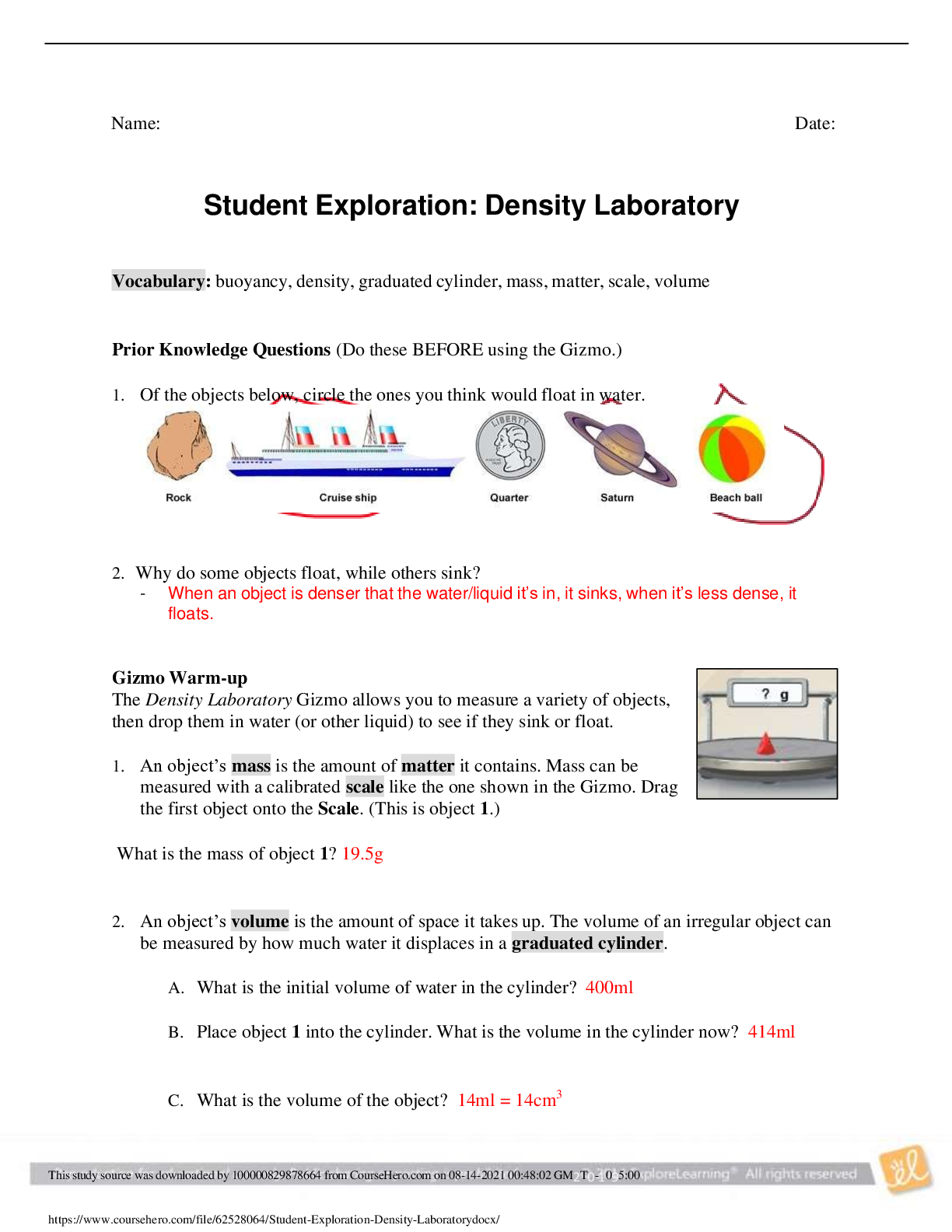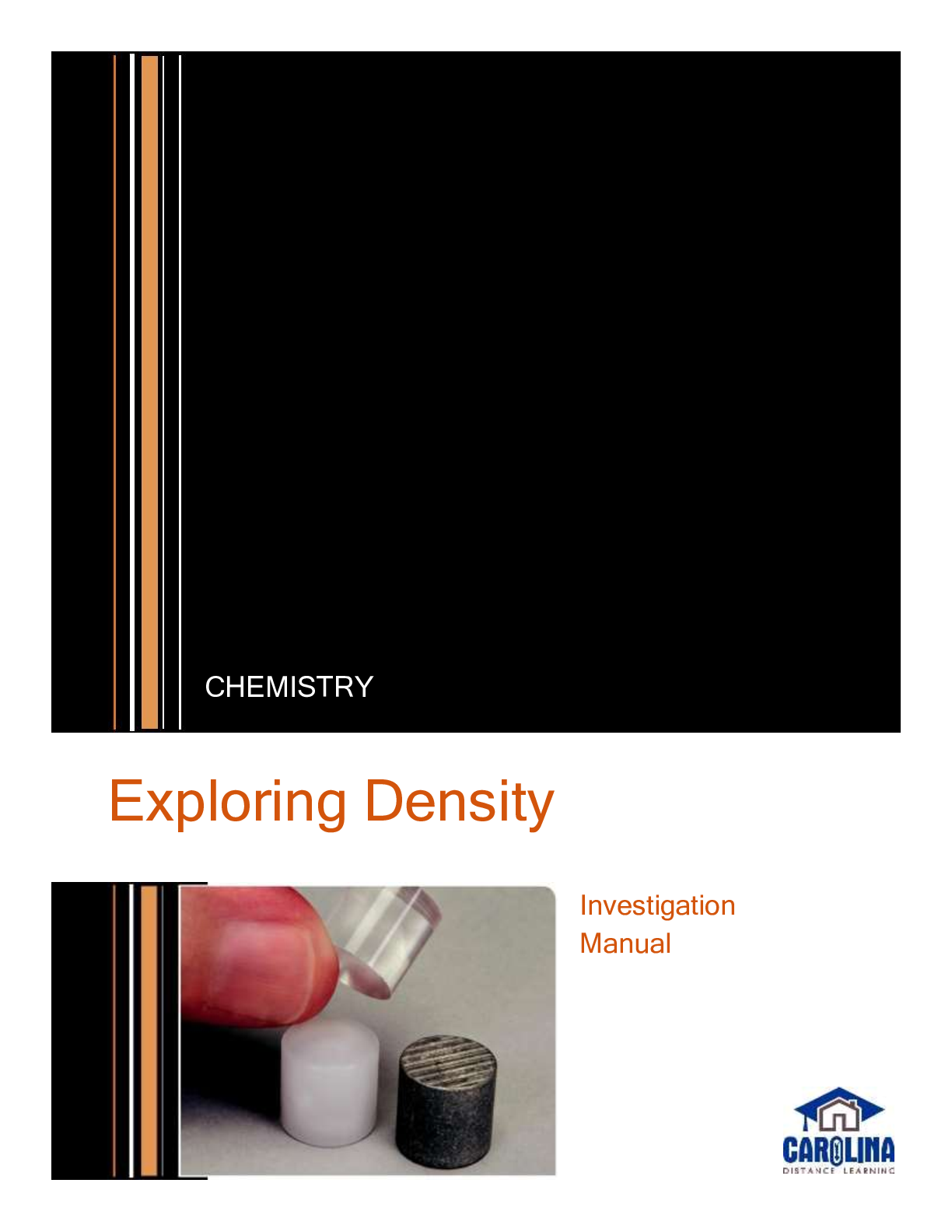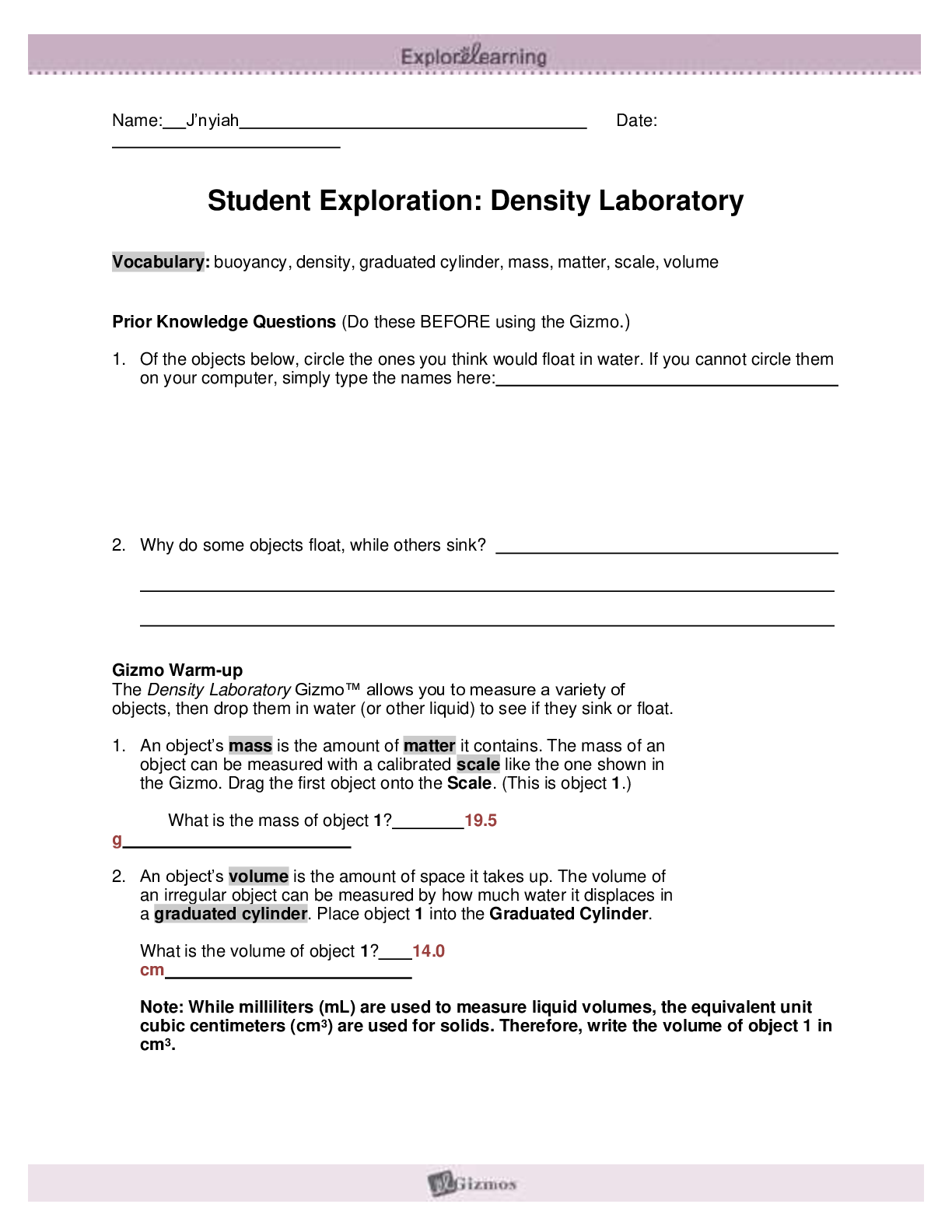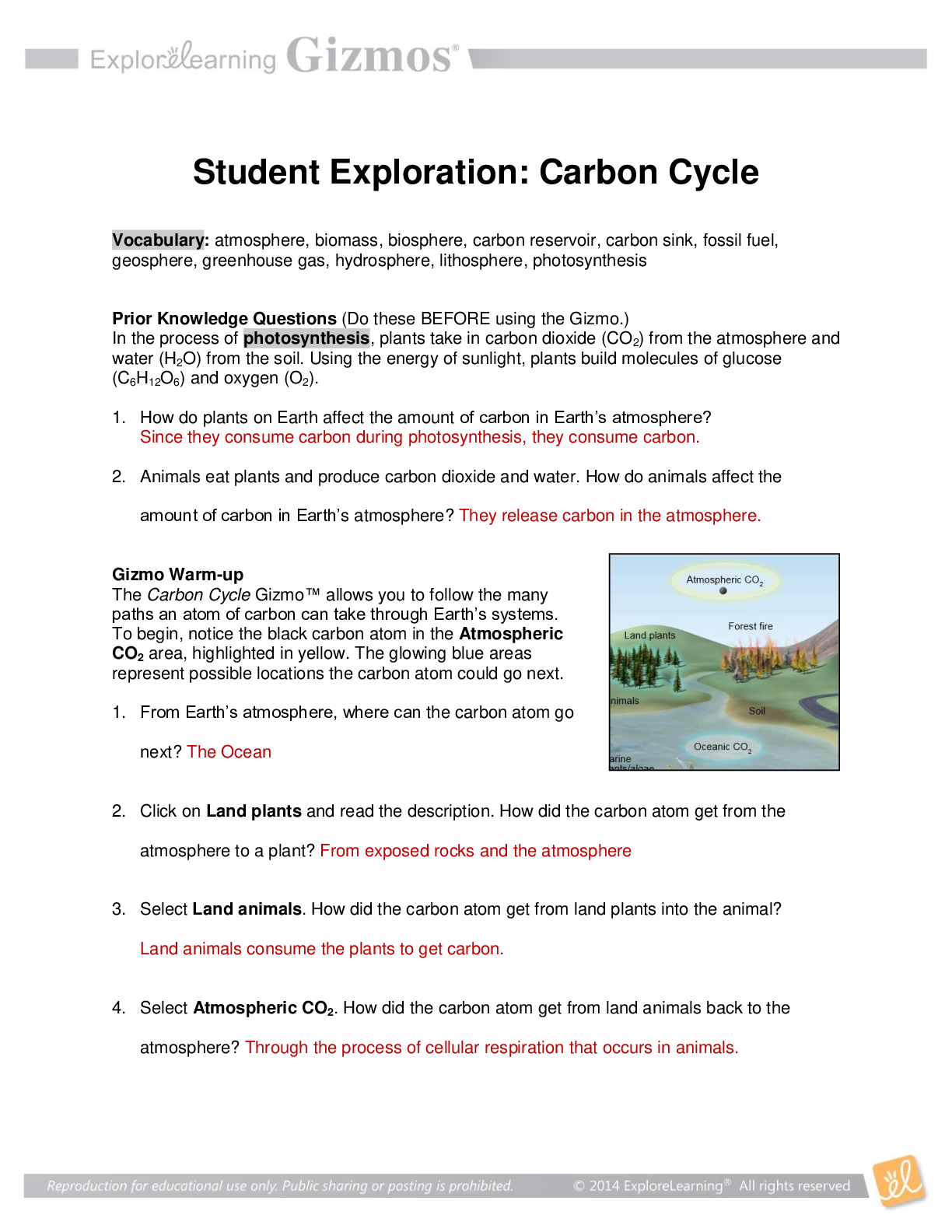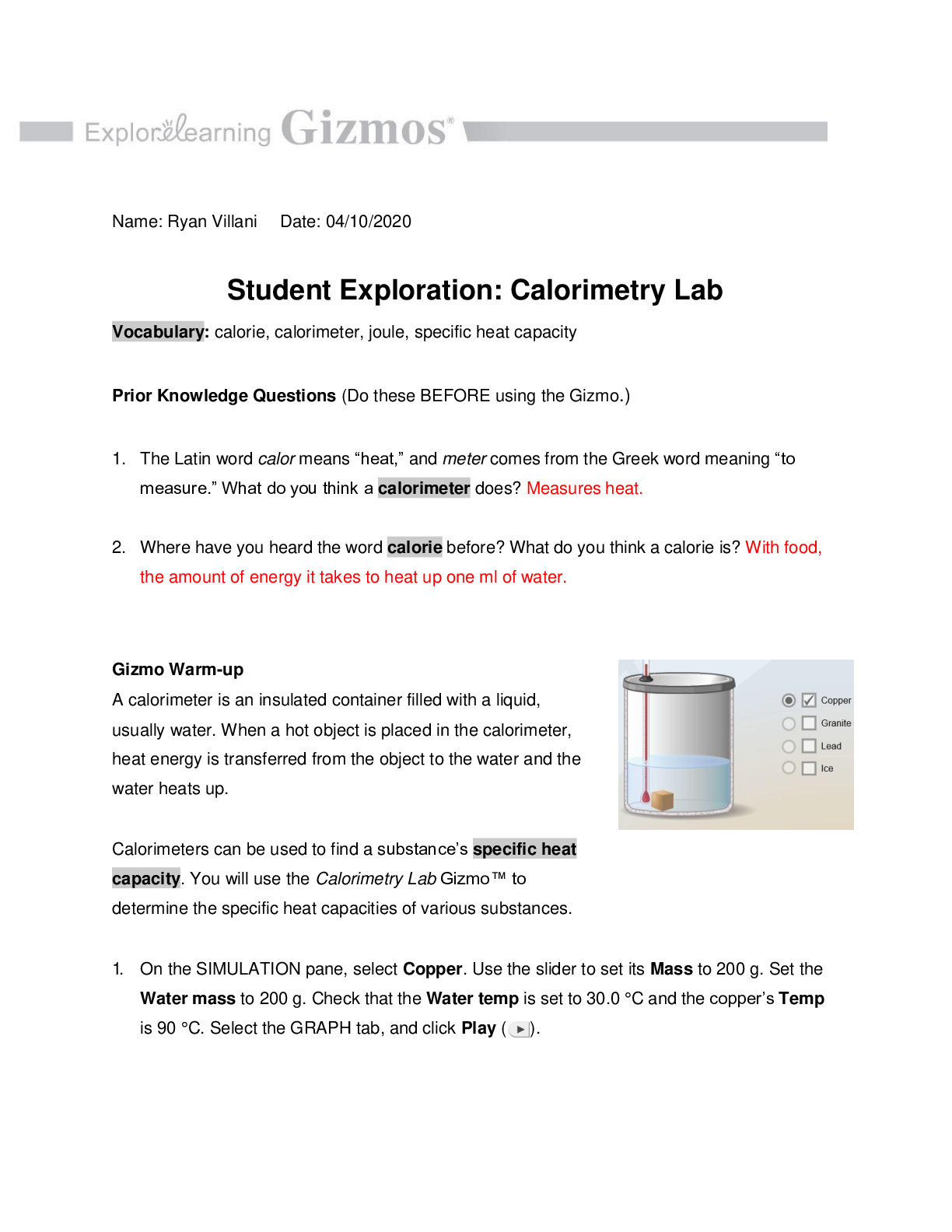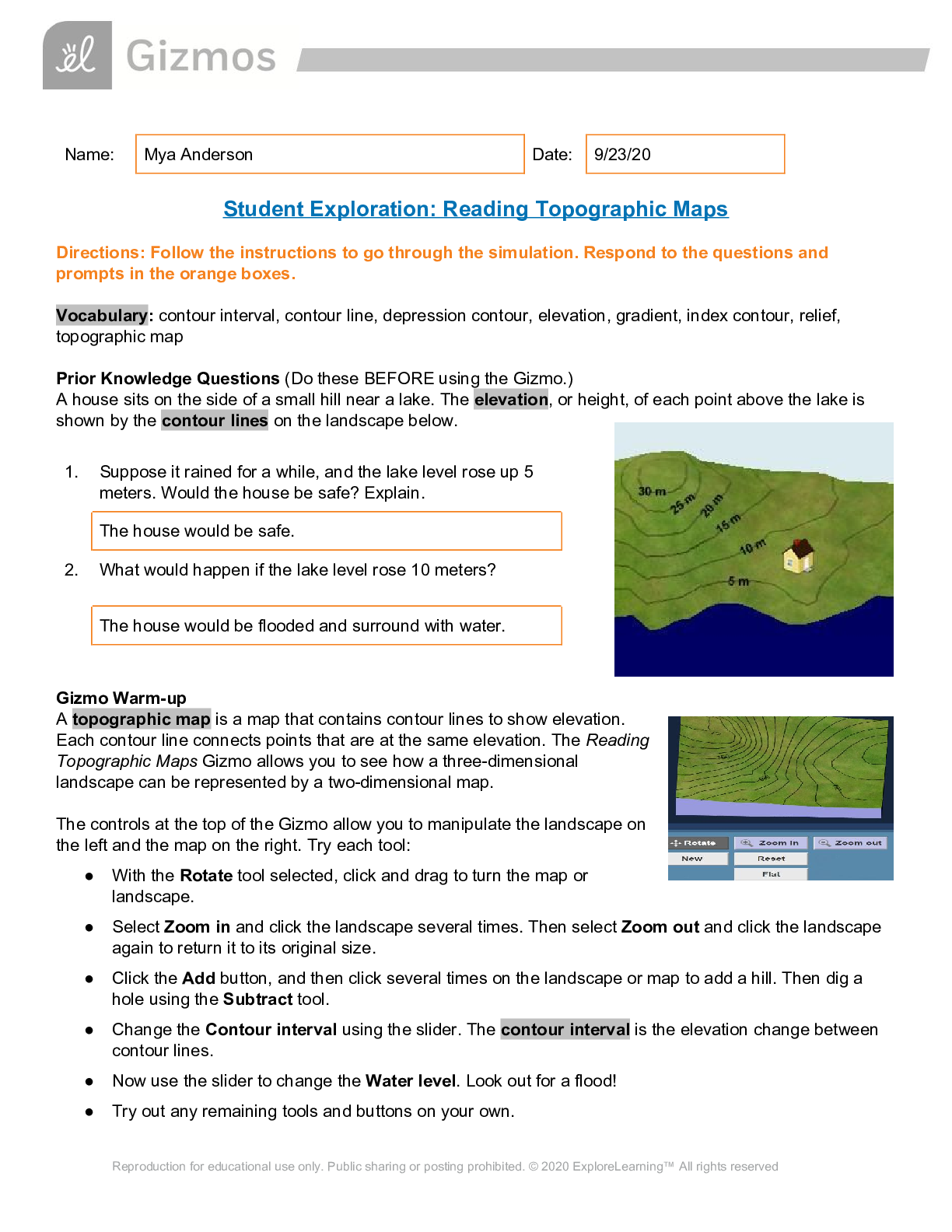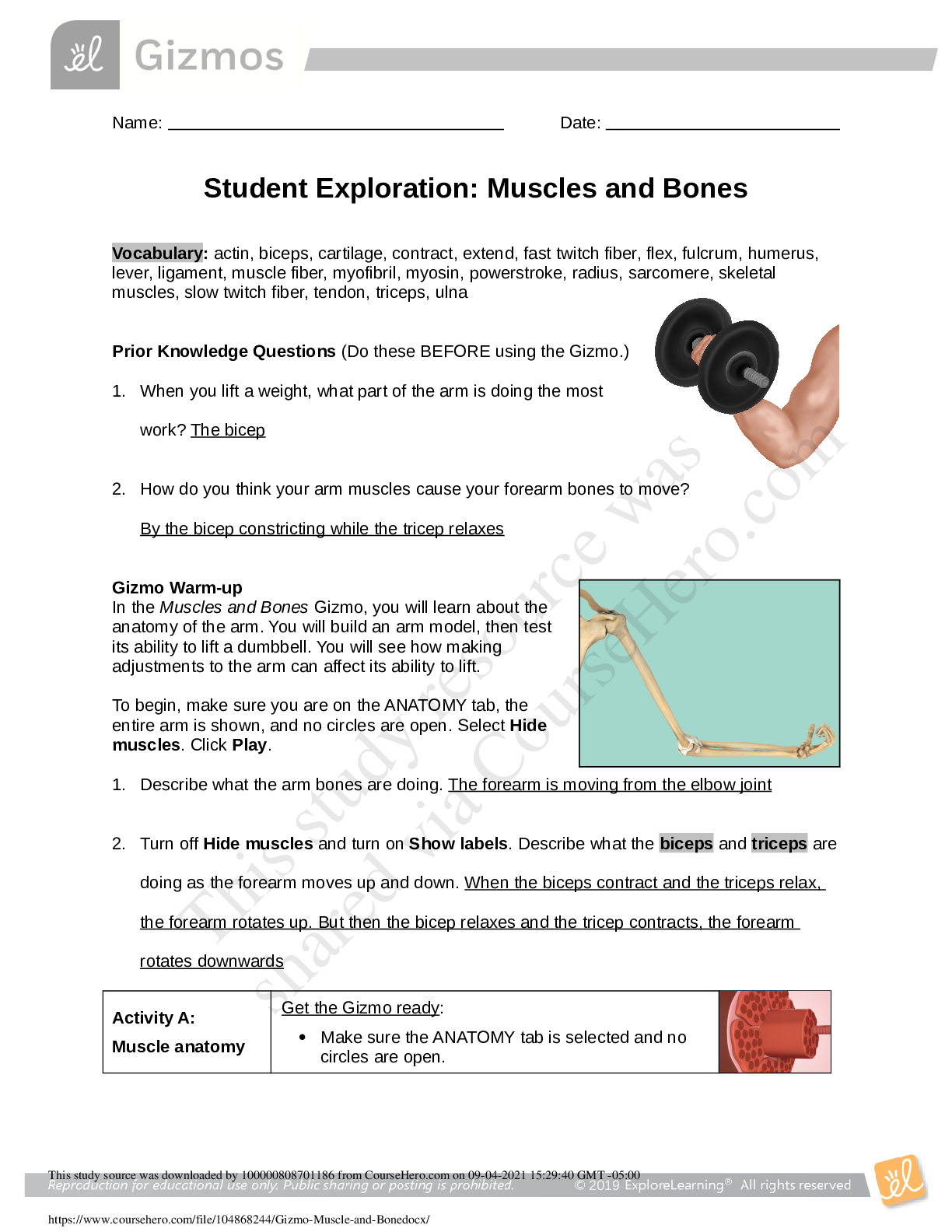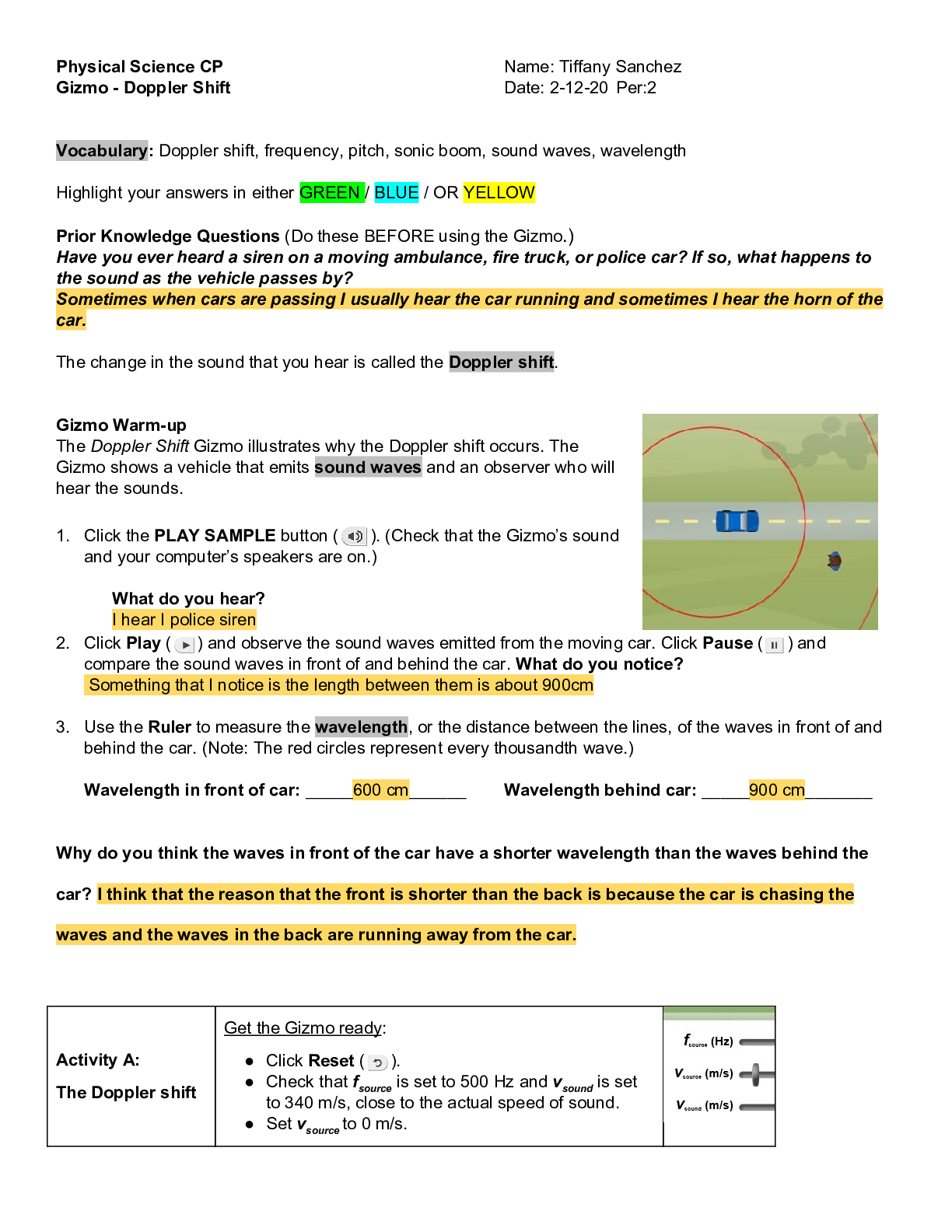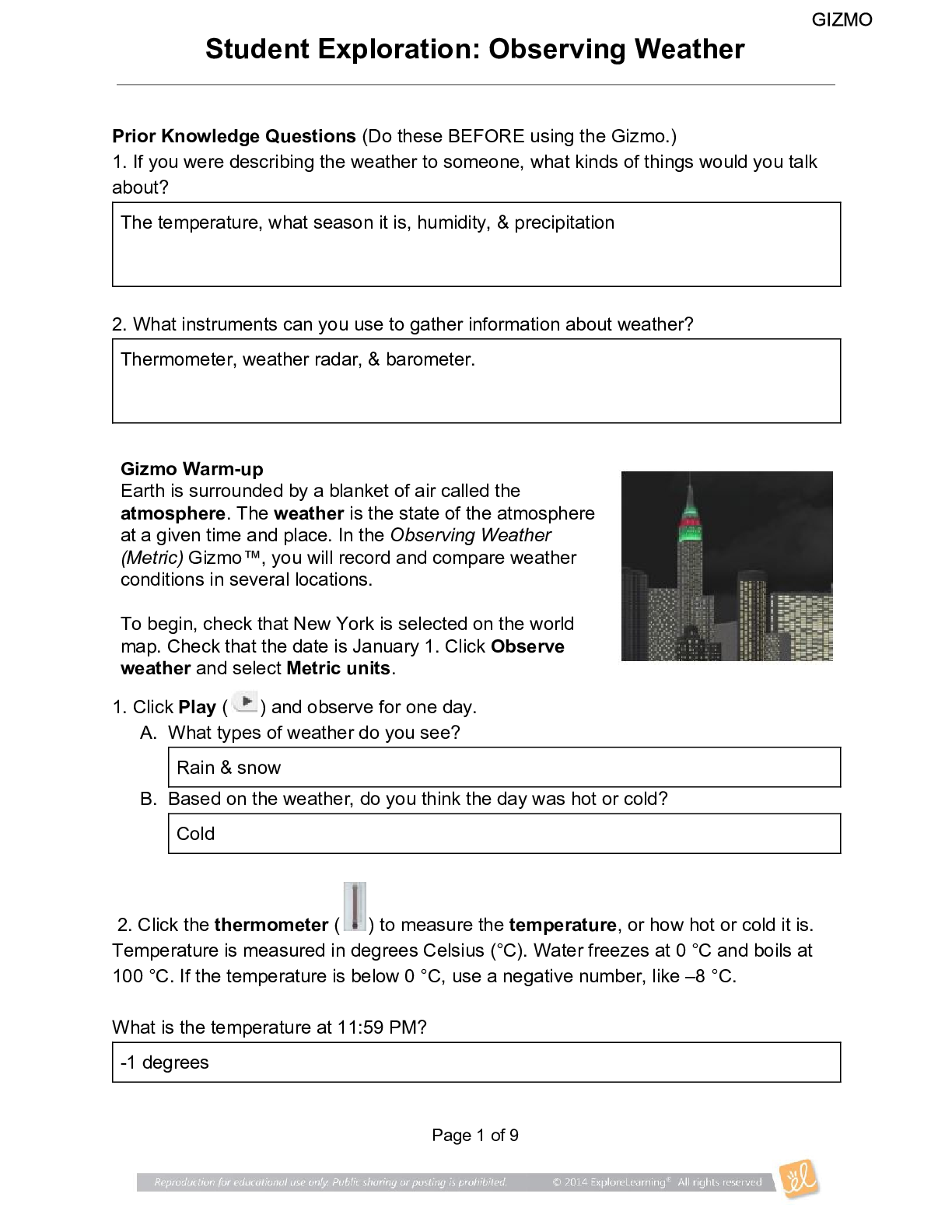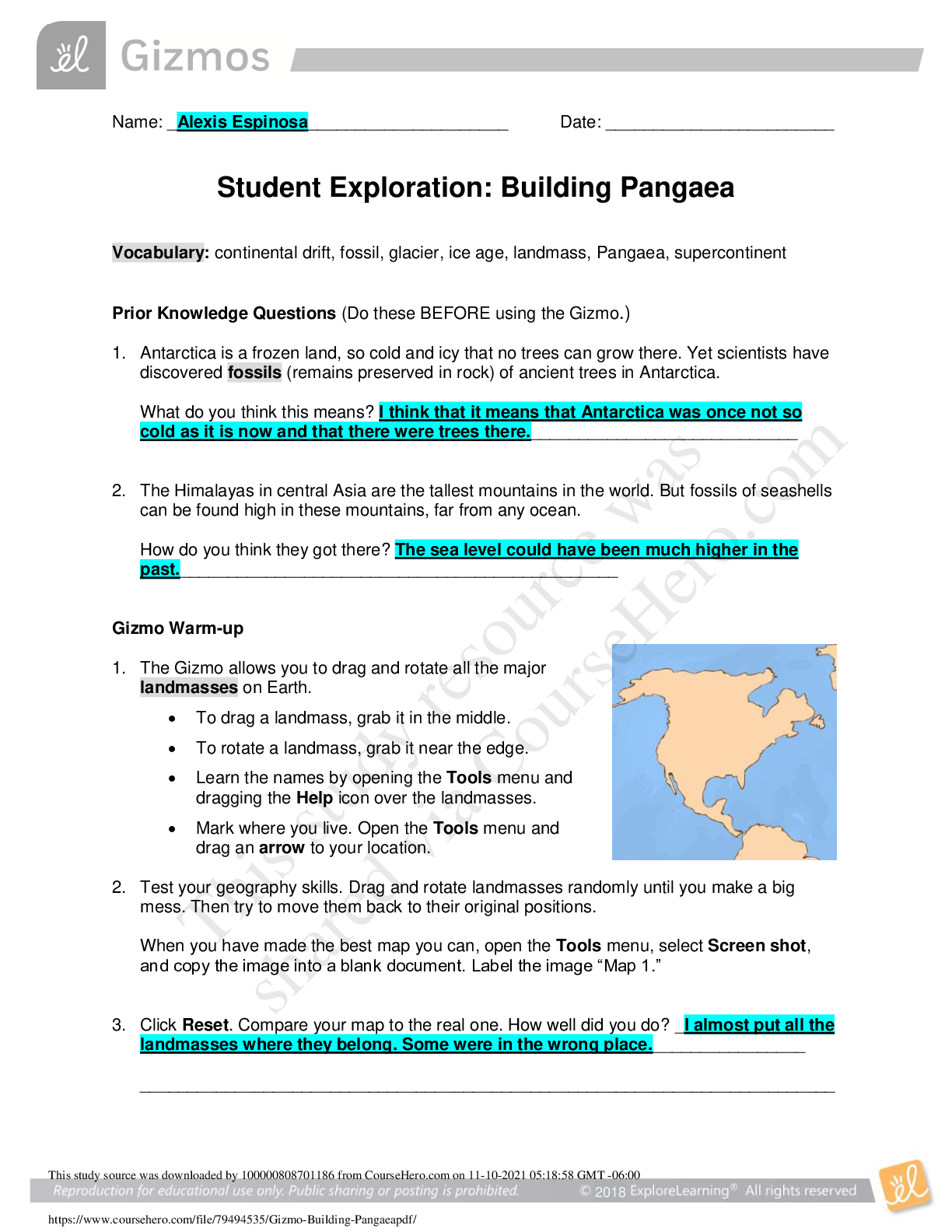PHYSICS Gizmo Student Exploration: Torque and Moment of Inertia
Document Content and Description Below
Name: Elise Escobar Date:
Student Exploration: Torque and Moment of Inertia
Directions: Follow the instructions to go through the simulation. Respond to the questions and prompts in the orange bo
...
xes.
Vocabulary: angular acceleration, fulcrum, lever, moment of inertia, Newton’s second law, torque, weight
Prior Knowledge Question (Do this BEFORE using the Gizmo.)
During recess, Tom and his little sister Marcie want to play on the see-saw. Tom is quite a bit heavier than Marcie. Where should they sit so the see-saw is balanced? Sketch their positions on the image below.
Explain your reasoning:
Gizmo Warm-up
The Torque and Moment of Inertia Gizmo shows a see-saw, which is a type of lever. The see-saw can hold up to eight objects. To begin, check that the Number of objects is 2. Check that the mass of object A is 1.0 kg and the mass of object B is
2.0 kg. The two objects are equidistant from the triangular
fulcrum that supports the lever.
1. Click Release. What happens?
2. Click Reset. Without changing the masses, experiment with different positions of objects A and B by dragging them around.
Activity A:
Principle of the lever Get the Gizmo ready:
● Click Reset. Turn on Show ruler.
● Check that object A is 1.0 kg and B is 2.0 kg.
Question: How can you use a light object to balance a heavy object?
1. Explore: Experiment with the Gizmo to see how you can balance a heavy object with a light object. What do you notice about the distances of each object from the fulcrum?
2. Gather data: For each mass and location of object A, find a location for object B so it perfectly balances object A. You can change the mass of object A by typing the mass into the text box and hitting “Enter” on your keyboard. Leave the mass of object B the same
(1 kg) in each experiment. Include all units in the table.
Object A mass Object A location Object B mass Object B location Object A
m × d Object B
m × d
1.0 kg -0.4 m 1.0 kg
2.0 kg -0.4 m 1.0 kg
3.0 kg -0.4 m 1.0 kg
4.0 kg -0.4 m 1.0 kg
3. Analyze: What patterns do you notice in your data?
4. Calculate: Fill in the last two columns by multiplying each object’s mass by its distance from the fulcrum. The units are kg·m. (Note: The distance d is always a positive number.)
5. Generalize: In general, how can you calculate the distance of object B from the fulcrum so that it balances object A?
6. Apply: Suppose you wanted to lift a heavy rock with a lever. Would you place the fulcrum near the rock or near the part of the lever where you are pushing? Explain.
Activity B:
Torque Get the Gizmo ready:
● Click Reset. Turn on Show initial torque.
● Set the Number of objects to 1.
● Set Mass A to 2.0 kg.
Question: What is the rotational force that an object exerts on a lever?
1. Calculate: When object A is positioned on the see-saw, it is pulled down by the force of gravity. The gravitational force on an object, or its weight (w), is equal to its mass multiplied by gravitational acceleration (g). Gravitational acceleration is 9.81 m/s2 on Earth’s surface.
[Note: The unit for weight is the newton (N).]
2. Predict: The twisting force an object exerts on a see-saw is called torque (τ). How do you think the torque depends on the distance of object A from the fulcrum?
3. Gather data: Place object A at several locations on the see-saw, on both sides of the fulcrum. Use a different mass in each experiment. In each trial, click Release and record the initial torque. Record object A’s mass, weight, location, and torque in the table below.
Object A mass (kg) Object A weight (N) Object A location (m) Object A torque (N·m)
4. Analyze: Based on your data, write an equation for torque. Use the symbol r to represent distance. For now, ignore the sign of the torque. Test your equation with the Gizmo.
5. Make a rule: Now focus on the sign of each torque value in your table. How does the sign relate to the direction of rotation? (Fill in each blank with “clockwise” or “counterclockwise.”)
If torque is positive, the resulting motion is
If torque is negative, the resulting motion is
6. Apply: What is the torque exerted by a 4.2-kg mass that is located 1.8 m to the right of the fulcrum?
Check your answer with the Gizmo.
7. Explore: Set the Number of objects to 2. Set the Mass of object A to 5 kg and its Location to 1.2 m. Set the Mass of object B to 3.0 kg and is Location to 0.5 m.
A. What torque does object A exert on the see-saw?
B. What torque does object B exert on the see-saw?
C. What do you think is the total torque on the see-saw?
D. Check that Show initial torque is on and click Release.
8. Practice: A lever supports four objects:
● Object A is 3.0 kg and located 2.0 m left of the fulcrum.
● Object B is 7.0 kg and located 0.5 m left of the fulcrum.
● Object C is 8.0 kg and located 0.1 m right of the fulcrum.
● Object D is 4.5 kg and located 1.6 m right of the fulcrum.
(Hint: Recall that objects to the right of the fulcrum will have a negative torque.)
Show your work:
B. When released, will the left rotate clockwise or counterclockwise?
C. Check your answers on the Gizmo. Were you correct?
9. Explain: If two kids are playing on the see-saw, why should the larger kid sit closer to the fulcrum than the smaller kid? Use the term “torque” in your explanation.
Activity C:
Moment of inertia Get the Gizmo ready:
● Click Reset.
● Check that the Number of objects is 1.
● Set Mass A to 2.0 kg.
Introduction: When describing the motion of rotating objects (such as see-saws), physicists use several terms that are equivalent to those used for linear motion. For example, torque (τ) is the rotational equivalent of force, while angular acceleration (α) is the rotational equivalent of linear acceleration.
Question: What factors affect how quickly a see-saw accelerates?
1. Predict: Two children of equal mass decide to have a see-saw race. Each child sits on an identical see-saw with nothing on the other side. William sits at the end of his see-saw as far away as possible from the fulcrum. Kate sits near the middle of her see-saw close to the fulcrum. Their friends lift both see-saws to the top and release them simultaneously.
Which see-saw do you think will hit the ground first, and why?
........................................................................continued................................................................................
[Show More]
Last updated: 3 years ago
Preview 1 out of 6 pages


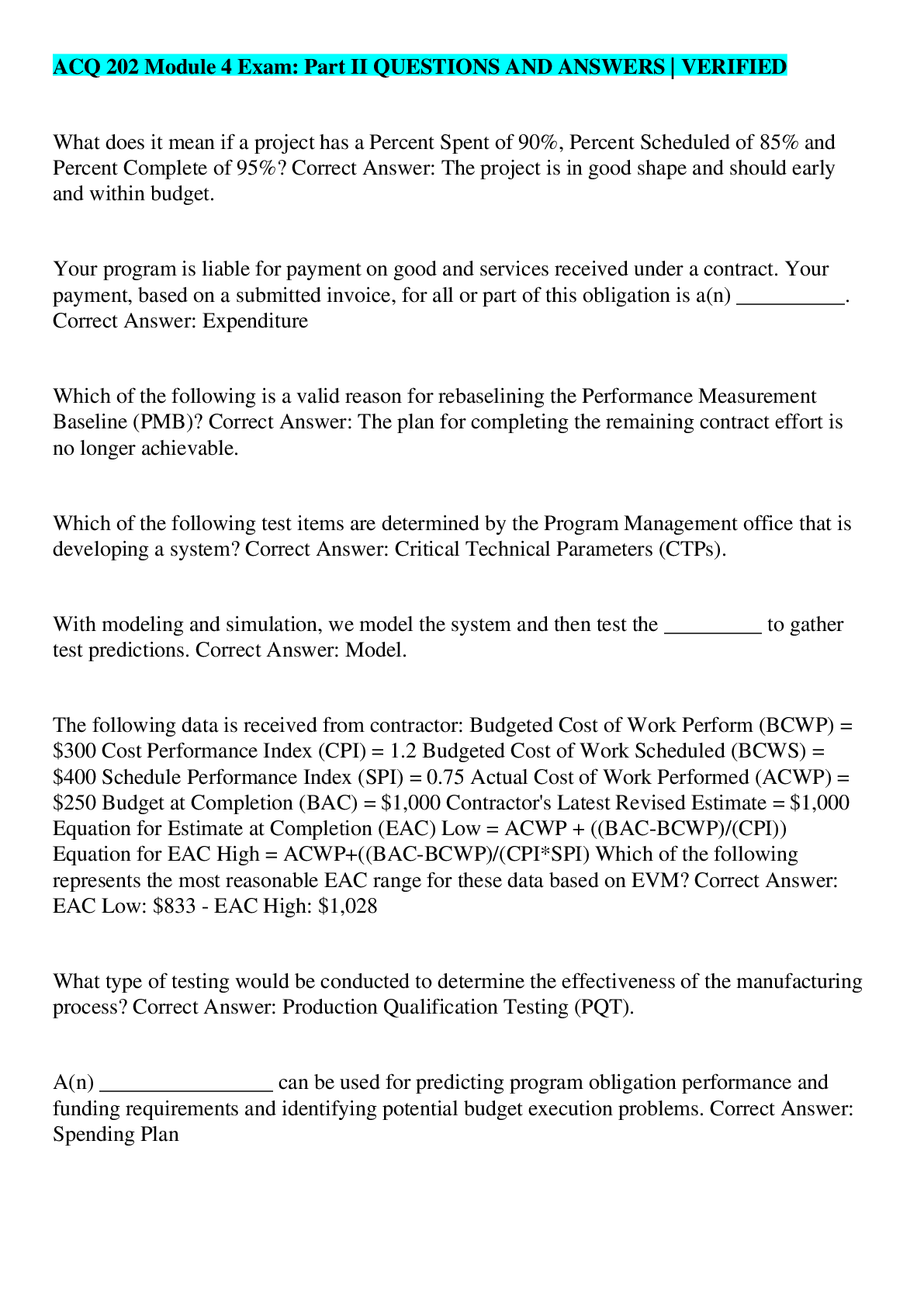




.png)


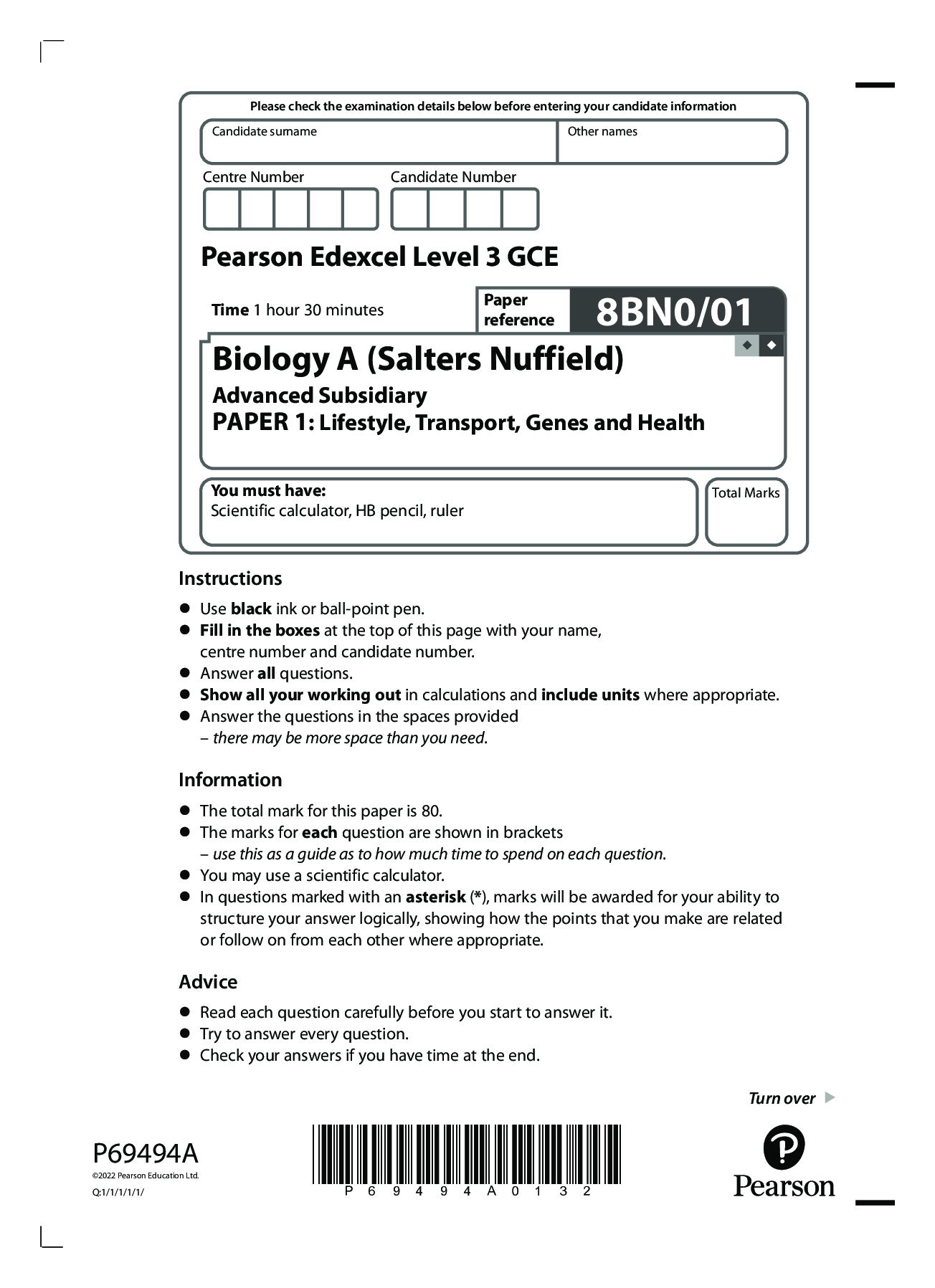

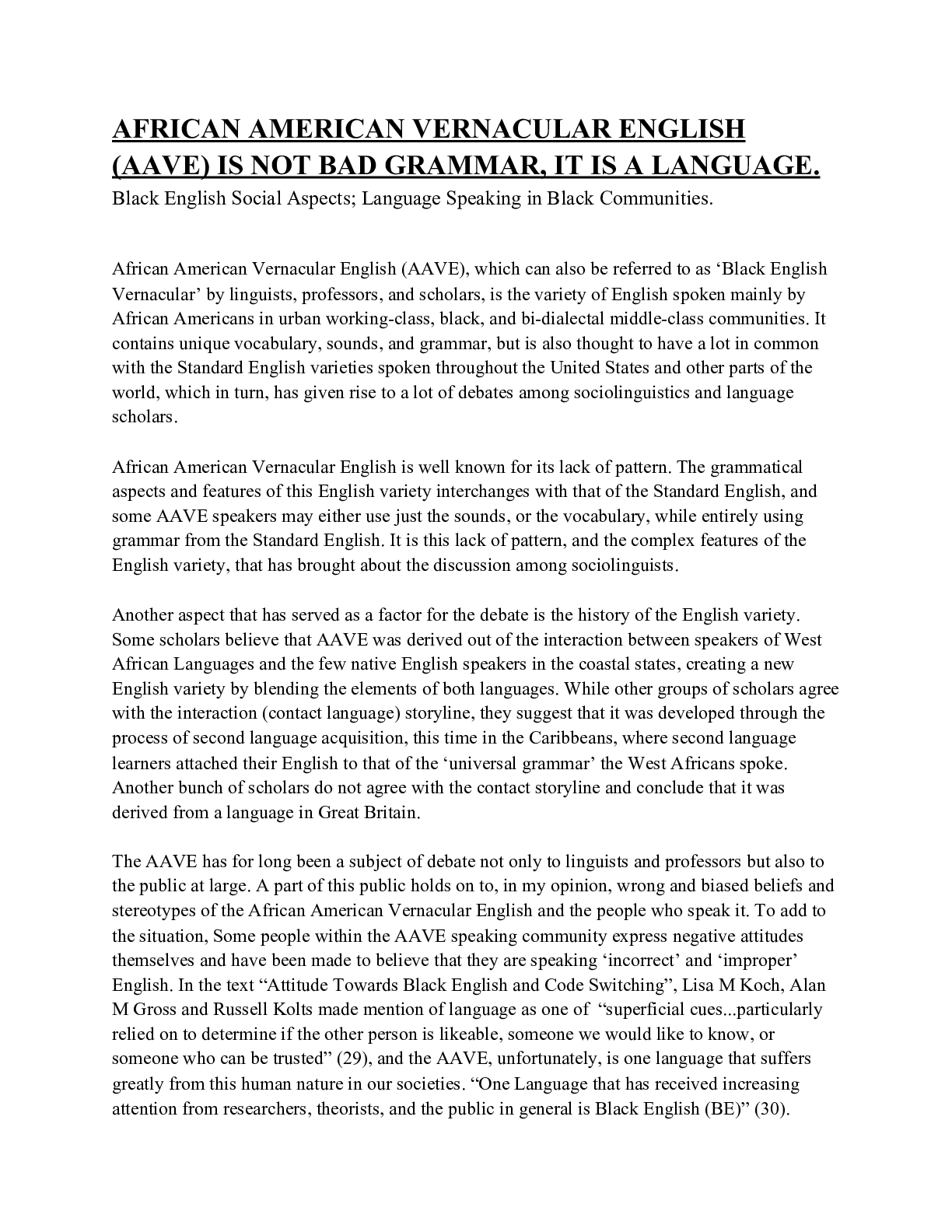
.png)


